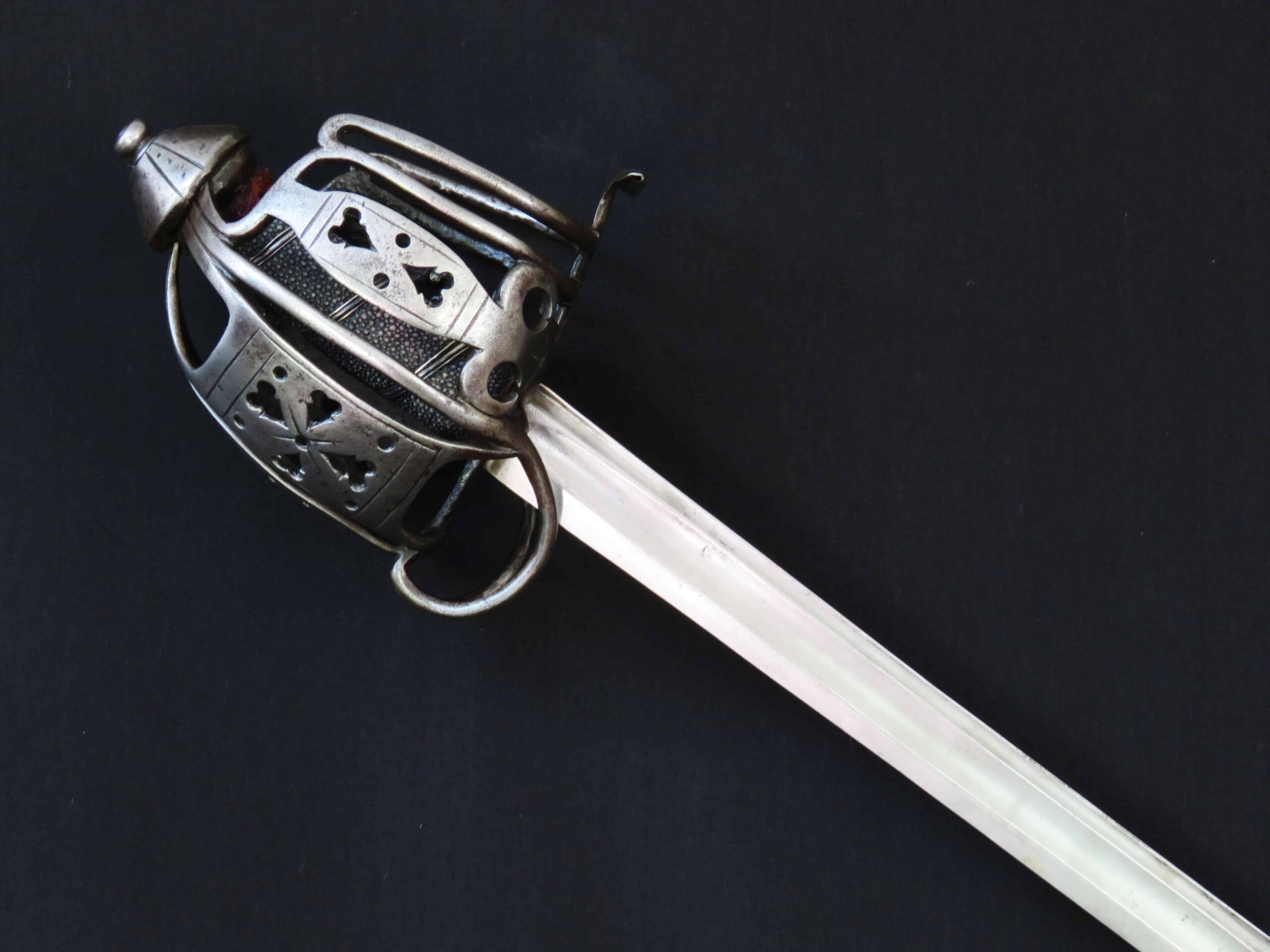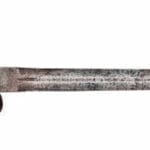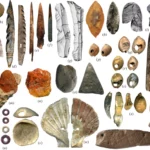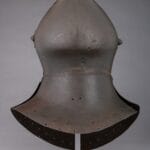Decoding the Basket Hilt: More Than Just a Guard
Ever fantasized about holding a piece of history, a weapon whispering stories of bygone battles? The basket hilt sword, a captivating blend of artistry and lethality, offers just that. Dominating battlefields for centuries, from the Renaissance through the Napoleonic Wars, this iconic weapon, with its signature basket-shaped guard, embodies a rich and complex history.
From Crossguard to Cage: The Evolution of Hand Protection
The basket hilt sword’s journey began not as the imposing weapon we envision, but with the simple crossguard designed to protect a knight’s fingers. Over time, this basic form evolved into the elaborate cage that defines the basket hilt. This transformation suggests a gradual process, likely driven by the need for increased hand protection in the chaotic melee of battle. One of the earliest examples, discovered on the wreck of the Mary Rose—a Tudor warship that sank in 1545—rewrites the timeline, placing the basket hilt firmly in the 16th century, a full century earlier than previously believed. This remarkable find offers a crucial glimpse into the early development of this iconic weapon and challenges prior assumptions about its origins. [https://www.lolaapp.com/basket-hilted-broadsword]
Anatomy of a Basket Hilt: Form and Function
The defining feature, the basket hilt, is a marvel of metalwork, extending from the crossguard to encase the hand. Its intricate design provided unparalleled protection against an opponent’s blade, deflecting cuts and thrusts that could disarm or injure a swordsman. Beyond defense, the basket hilt also served as a formidable offensive tool. The pommel, the weighty piece at the end of the grip, could deliver a crushing blow in close quarters. The blade itself, typically double-edged, offered versatility, capable of both powerful cuts and precise thrusts. Unlike the more elegant rapier, favored for duels and civilian self-defense, the basket hilt sword remained primarily a weapon of war, seeing action in conflicts like the English Civil War. [https://www.lolaapp.com/bascinet]
A Family of Swords: Exploring Variations
The term “basket hilt sword” encompasses a diverse range of distinct types, each reflecting unique regional preferences and military requirements.
- The Schiavona: Favored by Dalmatian soldiers in the Venetian naval infantry during the 16th and 17th centuries, the Schiavona stands out with its distinctive shell-shaped guard. This Italian-made sword proved a popular and highly effective sidearm.
- The Scottish Broadsword: Synonymous with Highland warriors, the Scottish broadsword became a potent symbol of Scottish military tradition. Often paired with a targe (small shield) and a dirk (smaller knife), it embodies a unique fighting style and a fierce sense of independence. The term “claymore” is often mistakenly applied to this single-handed weapon, creating confusion with the much larger two-handed claymore of medieval Scotland. Clarifying this distinction is essential for accurate historical understanding. The basket-hilted broadsword gained further prominence, particularly during the Jacobite risings, where it symbolized Scottish identity and rebellion. While not technically a basket hilt sword, lowland swords, with their long blades, side rings, and distinct hilt designs, are often mentioned in discussions of Scottish swords.
- The Mortuary Sword: Not all basket hilt swords were designed for battle. Mortuary swords, with their elaborate engravings and ornamentation, played a symbolic role in funeral processions and artistic representations of death. These ceremonial pieces offer a glimpse into the broader cultural significance of swords beyond the battlefield.
- The Jacobite Basket Hilt Sword: This specific type, featuring a distinctive brass basket often lined with red cloth, further exemplifies the diversity within the basket hilt family.
A Collector’s Pursuit: Preserving History
Today, basket hilt swords are highly sought-after by collectors. They represent tangible links to history, connecting us to the individuals who wielded them and the pivotal battles that shaped nations. Identifying genuine antique basket hilt swords demands careful study. Hilt design, blade characteristics, and any markings indicating origin and age—some requiring an expert eye—are crucial factors. Preservation is paramount. These aren’t mere display pieces; they are artifacts deserving meticulous care. Proper storage, cleaning, and maintenance, considering factors like humidity and temperature, are essential to safeguard these historical treasures for future generations. Ongoing research continues to unveil new insights into their design, use, and cultural impact, suggesting that our current understanding may evolve with future discoveries.
What is a Basket Hilt Sword Called? Addressing the Terminology
The term “basket hilt sword” itself often causes confusion. While generally accurate, “basket hilt” actually describes the guard, not a specific sword type. Various swords, including the Scottish broadsword and the schiavona, feature this protective element. The Scottish broadsword is sometimes misleadingly called a “claymore,” a term originally reserved for a much larger two-handed medieval Scottish sword. In Gaelic, both the single-handed and two-handed swords might be called “claidheamh mòr,” meaning “great sword.” To further complicate matters, the basket-hilted broadsword is sometimes referred to as an “Andrea Ferrara,” likely alluding to a renowned family of Italian bladesmiths or possibly as a generic term for high-quality blades of that era. This complex terminology highlights the rich history and varied origins of these iconic weapons.
The Mary Rose Revelation: Rewriting the History of the Basket Hilt
The discovery of a basket hilt sword on the wreck of the Mary Rose, which sank in 1545, revolutionized our understanding of this weapon. This find predates previously known examples by a century, pushing the timeline back to the Tudor era and challenging the assumption that the earliest basket hilts dated to the English Civil War. It suggests a more gradual evolution, likely originating from simpler crossguard designs. The Mary Rose sword also adds a compelling English dimension to the narrative, often dominated by the Scottish association. While the exact path of the basket hilt’s development remains an area of ongoing research, this discovery serves as a powerful reminder that historical narratives are constantly being refined by new evidence.
The Scottish Broadsword: Claymore, Claidheamh Mòr, or Basket Hilt?
The Scottish broadsword, a single-handed weapon with a distinctive basket hilt, is often mistakenly referred to as a “claymore.” While “claymore” is commonly used, it originally denoted a much larger two-handed medieval Scottish sword. The single-handed version gained prominence during periods like the Jacobite risings, becoming a symbol of Scottish warrior identity. The Gaelic term “claidheamh mòr,” meaning “great sword,” can refer to either type, adding to the confusion. The nickname “Andrea Ferrara,” probably referring to a family of Italian bladesmiths or possibly used as a generic term for quality blades, adds another layer to the naming puzzle. The protective basket hilt itself provided crucial hand protection in combat, making the Scottish broadsword a formidable weapon in the hands of Highland warriors. The development of the basket hilt has even been theorized by some experts to have influenced changes in sword fighting styles, potentially leading to a greater emphasis on cut-and-thrust techniques. This, however, remains an area needing further research. The Scottish broadsword’s historical importance, combined with the craftsmanship and symbolism it embodies, makes it a prized artifact for collectors today.
This nuanced exploration of the basket hilt sword offers a deeper appreciation of its historical significance, intricate design, and enduring legacy. By addressing common misconceptions and highlighting ongoing research, this guide provides a more comprehensive understanding of this iconic weapon, inviting further exploration into the captivating world of historical arms and armor.
- Georgia Platform: A Southern Strategy, 1850s - March 31, 2025
- How many weeks is 40 days: Quick Conversion Guide for Accurate Results - March 31, 2025
- How many feet is 300 meters? 984 Feet: Understand Length Conversions Easily - March 31, 2025

















2 thoughts on “The Basket Hilt Sword: A Collector’s Guide to History, Types, and Value”
Comments are closed.